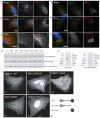SNX15 links clathrin endocytosis to the PtdIns3P early endosome independently of the APPL1 endosome
- PMID: 23986476
- PMCID: PMC3820240
- DOI: 10.1242/jcs.125732
SNX15 links clathrin endocytosis to the PtdIns3P early endosome independently of the APPL1 endosome
Abstract
Sorting nexins (SNXs) are key regulators of the endosomal network. In designing an RNAi-mediated loss-of-function screen, we establish that of 30 human SNXs only SNX3, SNX5, SNX9, SNX15 and SNX21 appear to regulate EGF receptor degradative sorting. Suppression of SNX15 results in a delay in receptor degradation arising from a defect in movement of newly internalised EGF-receptor-labelled vesicles into early endosomes. Besides a phosphatidylinositol 3-phosphate- and PX-domain-dependent association to early endosomes, SNX15 also associates with clathrin-coated pits and clathrin-coated vesicles by direct binding to clathrin through a non-canonical clathrin-binding box. From live-cell imaging, it was identified that the activated EGF receptor enters distinct sub-populations of SNX15- and APPL1-labelled peripheral endocytic vesicles, which do not undergo heterotypic fusion. The SNX15-decorated receptor-containing sub-population does, however, undergo direct fusion with the Rab5-labelled early endosome. Our data are consistent with a model in which the EGF receptor enters the early endosome following clathrin-mediated endocytosis through at least two parallel pathways: maturation through an APPL1-intermediate compartment and an alternative more direct fusion between SNX15-decorated endocytic vesicles and the Rab5-positive early endosome.
Keywords: APPL1; Clathrin; Endosome; Phosphoinositide; Sorting nexin.
Figures








References
-
- Carlton J., Bujny M., Peter B. J., Oorschot V. M., Rutherford A., Mellor H., Klumperman J., McMahon H. T., Cullen P. J. (2004). Sorting nexin-1 mediates tubular endosome-to-TGN transport through coincidence sensing of high- curvature membranes and 3-phosphoinositides. Curr. Biol. 14, 1791–1800 10.1016/j.cub.2004.09.077 - DOI - PubMed
-
- Choudhury R., Diao A., Zhang F., Eisenberg E., Saint-Pol A., Williams C., Konstantakopoulos A., Lucocq J., Johannes L., Rabouille C. et al.(2005). Lowe syndrome protein OCRL1 interacts with clathrin and regulates protein trafficking between endosomes and the trans-Golgi network. Mol. Biol. Cell 16, 3467–3479 10.1091/mbc.E05-02-0120 - DOI - PMC - PubMed
-
- Cozier G. E., Carlton J., McGregor A. H., Gleeson P. A., Teasdale R. D., Mellor H., Cullen P. J. (2002). The phox homology (PX) domain-dependent, 3-phosphoinositide-mediated association of sorting nexin-1 with an early sorting endosomal compartment is required for its ability to regulate epidermal growth factor receptor degradation. J. Biol. Chem. 277, 48730–48736 10.1074/jbc.M206986200 - DOI - PubMed
Publication types
MeSH terms
Substances
Grants and funding
LinkOut - more resources
Full Text Sources
Other Literature Sources
Miscellaneous

